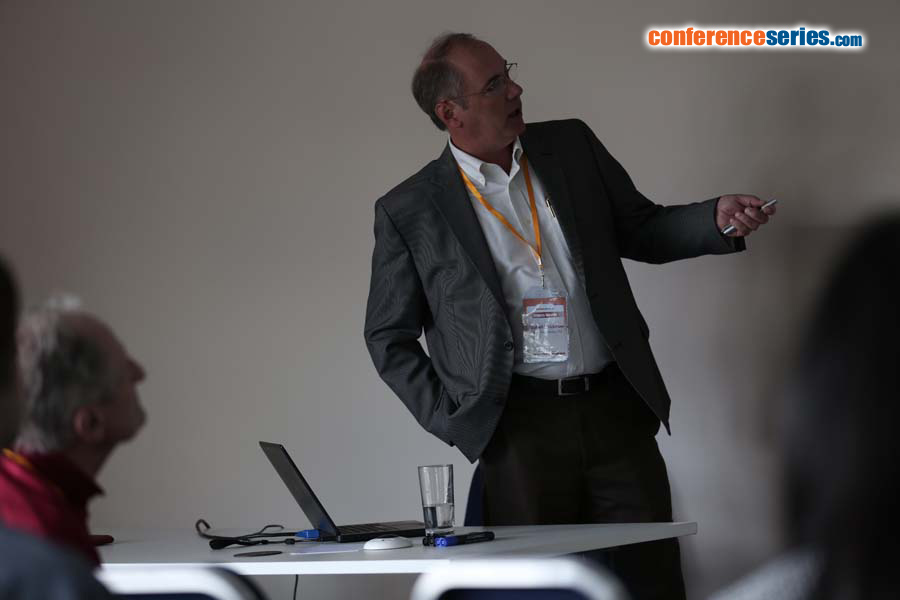
Michael L. Nickerson
National Institutes of Health Bethesda, USA
Title: Altered UBIAD1 prenyltransferase function in schnyder cornea dystrophy affects cholesterol metabolism and mitochondrial function
Biography
Biography: Michael L. Nickerson
Abstract
Schnyder corneal dystrophy (SCD) is an autosomal dominant disease characterized by deposition of cholesterol in the cornea, progressive opacification, and loss of visual acuity. Germline UBIAD1 variants introduce missense mutations in over 50 SCD families, including four large families from Finland who share a likely founder mutation. UBIAD1 was recently shown to catalyze synthesis of two mitochondrial electron carriers, menaquinone-4 (MK-4) and coenzyme Q10/ubiquinone (CoQ10). MK-4 is the predominant active form of vitamin K and an important cofactor in bone metabolism and blood clotting. We show SCD-altered UBIAD1 results in reduced MK-4 synthesis and molecular models indicate mutations disrupt active site residues and transmembrane helices. Yeast two-hybrid screening, co-immunoprecipitation, and confocal microscopy show a physical interaction between UBIAD1 and the cholesterol synthesis and storage enzymes HMGCR and SOAT1. Molecular models indicate cholesterol and geranylgeranyl diphosphate, a substrate for MK-4 synthesis, binding the same substrate binding cleft and likely compete for occupancy of UBIAD1. Vitamin K was originally identified by depletion of dietary cholesterol in chickens, which co-depleted vitamin K resulting in hemorrhages and uncontrolled bleeding. Our data suggests a first physiologic role for endogenously produced vitamin K in maintaining cornea health and visual acuity, in addition to its role in blood clotting. The data indicates that the synthesis of vitamin K, CoQ10 and cholesterol may be tightly linked with implications for vision, mitochondria function, cardiovascular health and cancer.
Recent Publications
- Nickerson M L, Bosley A, Weiss J S, Kostiha B N, Hirota Y, Brandt W, Esposito D, Kinoshita S, Wessjohann L, Morham S G, Andresson T, Kruth H S, Okano T, and Dean M (2013) The UBIAD1 prenyltransferase links menaquinone-4 synthesis to cholesterol metabolic enzymes. Hum Mutat 34: 317-329.
- Fredericks, W J, Mc Garvey, T Wang, H Zheng Y, Fredericks N J, Yin H, Wang, L P, Hsiao W, Lee R, Weiss J S, Nickerson, M L Kruth, H S Rauscher F J and Malkowicz S B (2013) The TERE1 protein interacts with mitochondrial TBL2: regulation of transmembrane potential, ROS/RNS and SXR target genes. J Cell Biochem 114 (9): 2170-87.
- Fredericks W J, Mc Garvey T, Wang H, Lal P, Puthiyaveettil R, Tomaszewski J, Sepulveda J, Labelle E, Weiss J S, Kruth H S, Brandt W, Wessjohann L A and Malkowicz S B (2011) The bladder tumor suppressor protein TERE1 (UBIAD1) modulates cell cholesterol: Implications for tumor progression. DNA Cell Biol 11: 851-64.
- Nickerson M L, Kostiha B N, Brandt W, Fredericks W, Xu K P, Yu F S, Gold B, Chodosh J, Goldberg M, Lu D W, Yamada M, Tervo T M, Grutzmacher D, Croasdale C, Hoeltzenbein M, Sutphin J, Malkowicz S B, Wessjohann L, Kruth H S, Dean M and Weiss J S (2010) UBIAD1 mutations alter a mitochondrial prenyltransferase to cause Schnyder Corneal Dystrophy. PLoS ONE 5 (5): e10760.
- Weiss J S, Kruth H S, Kuivaniemi H, Tromp G, White P S, Winters R S, Lisch W, Henn W, Denninger E, Krause M, Wasson P, Ebenezer N, Mahurkar S and Nickerson M L (2007) Mutations in the UBIAD1 gene on chromosome 1p36 cause schnyder crystalline corneal dystrophy. Invest Ophthalmol Vis Sci 48: 5007-5012.




